Beijing's Classic Car Museum |
 |
“There are nine million bicycles in Beijing” if the lyrics of Katie Meloua’s pop song are anything to go by; but from a nation of bikers and donkey cart drivers, China’s love affair with the motor car has spiralled practically out of control in just a generation.
Automobile sales on the mainland have been doubling almost every year for over a decade and earlier this year Beijing began trying to alleviate traffic congestion by restricting how many vehicles could be bought in the city. Since the policy's advent, residents have only been able to obtain license plates by taking part in a lottery. By September, more than 742,000 people had played the lottery and the odds of winning it are now less that one in 30.
So it is particularly apposite that Beijing now sports not one, but three car museums: the Beijing International Automotive Expo Center in Fengtai, in the south-western corner of the capital; another collection in Fengtai – this one belonging to the Beijing Bayi Film Studio; and the Classic Car Museum, located in Huairou about 40kms north of Beijing.
This latter was opened to the public in May 2009 and contains some 160 cars, many of which are classic Chinese makes, the likes of which many people in the west may never have heard, including a number of luxury government ‘Hong Qi’ (Red Flag) cars, known as “the Rolls Royce of China.”.
During China’s 60th anniversary parade on October 1, 2009, President Hu Jintao reviewed Chinese troops from a Hong Qi HQE. Earlier dignitaries going all the way back to Chairman Mao were also enamoured of this Chinese icon.
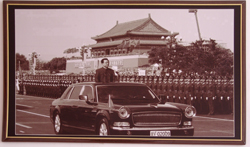
The owner of this private museum is Luo Wenyou, an antique car collector who started out as a miner and then built a successful delivery business from scratch, before selling it in 1983 to finance his hobby. His classic car collection started with an ‘Old Shanghai’ car worth 20 thousand yuan ($3,000), and then he spent a further 10 million yuan on a deserted workshop, which developed into his classic car museum.
“Hong Qi may well be a household name in China,” Luo explains through an interpreter, “but its origin is not so well known. In 1958, about a year before the 10th anniversary of the founding of the republic, the government ordered the country's main automobile manufacturer to produce a local car brand in time for an anniversary parade.
“Under pressure, the factory workers purchased a Chrysler car, dismantled it, hand-painted every part of it and then re-created an exact copy. On October 1, 1959, ten ‘Red Flag’ cars took part in the parade.”
The longest Hong Qi saloon car in Luo’s museum is a 1960s model about 10.8-metres long. Former President Jiang Zemin was so interested in it that he had himself photographed in front of it in October 2009, even though no one is quite sure who actually used it.
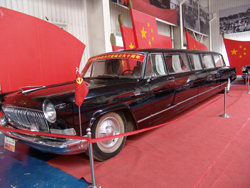
Luo’s Hong Li fleet also includes the convertible vehicle Chairman Mao used for army inspections as well as a car that once belonged to former leader Deng Xiaoping.
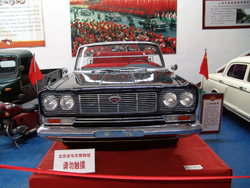
Close by there is another limousine which looks quite normal from the outside, but inside it has been kitted out as an ambulance and it is said that this car was always in close proximity to Chairman Mao whenever he went drive-about in his later years, just in case of an emergency.
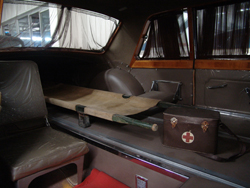
Many of Luo’s cars are still driveable, including one of the earliest saloon cars made after the founding of the People’s Republic - the Dongfeng CA71, created in 1958 and based on a Russian design. On its front end in Chinese calligraphy, is the name ‘First Automobile Works’ and the car’s logo is a golden dragon. Its tail lights are fashioned in the shape of a traditional Chinese lantern.
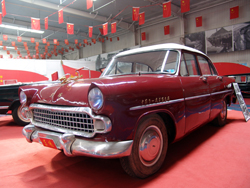
As well as this classic Chinese ‘cartopia’, we are also shown some European models that Luo has managed to get his hands on. There is a Gaz-69 Soviet army vehicle, motorcycles with sidecars that were used by the German army in World War Two, some Austin 7s, an old Rolls Royce,
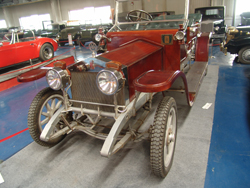
Dodge, Mercedes-Benz,
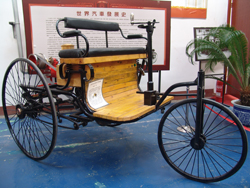
Morris, and even a Citroen 2CV (sporting a Mongolian number plate) which the Chinese find very funny. “If you couldn’t get your shopping through the door, you simply lifted off the roof” says Luo, falling about laughing as he must have done on countless previous retellings. “But its suspension was excellent for taking home a bag of eggs without breaking a single one!”
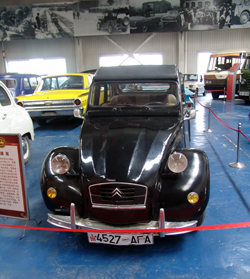
One of Luo’s prized possessions is a cart dating back to the Qing Dynasty – saved from destruction by overzealous Red Guards during the Cultural Revolution by someone having the brilliant idea of carving a quotation from ‘The Great Helmsman’ – Chairman Mao - onto the wooden front cross member. The Guards were loathe to destroy something which reflected Mao’s oratory, and a priceless piece of history was saved.
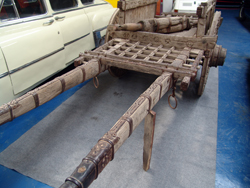
Luo Wenyou’s Classic Car Museum can be found in Yangsong Town, Huairou District - a 40 minute ride by bus 916 from Dongzhimen. Entry is 50 yuan (US$8).
